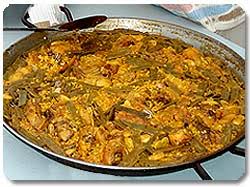As Spain’s national dish, Paella is well represented on the Internet. Too well represented in fact, because when you Google Paella you’ll be presented with a bewildering array of websites. How do you tell the best from the also-rans? Maybe I can help.
Paella, like its Italian counterpart, Risotto, should be made from a few simple, good quality ingredients, to allow the combination of flavours to come through to the palate. Unfortunately, Paella and Risotto have been hijacked by what I call the ‘Leftover Specialists.’ In other words, the symphony of flavours that is a true Paella Valenciana has been turned into cheap pop music by so-called chefs who should know better. Paella Valenciana includes chicken, rabbit, sometimes duck, maybe a few snails, rice, of course, various spices, tomatoes and beans. Let’s look at some Paella recipes on the Web and separate the heroes from the villains.
The best Internet Paella recipe is at Alicante-Spain.com. The recipe is for authentic Paella Valenciana, courtesy of site owner Hubertus Keil’s Spanish mother-in-law. The instructions are clear and concise, and there’s even a video demonstration to help you make the perfect Paella Valenciana, plus lots more background information.
Spanish cookery writer Janet Mendel has some good tips for preparing Paella and gives lots of interesting background information on its origins, plus other similar recipes. Not a true Paella Valenciana, but at least the extra added ingredients, such as peppers, combine well to make an authentic Spanish dish.
I never thought I’d accuse Delia Smith of being a cookery villain, as I’ve used lots of her recipes successfully. But when it comes to Paella, Delia makes the all-too-common mistake of non-Spanish cooks: she adds onions and Chorizo sausages. Onions dominate the other flavours which are absorbed into the rice, so they should never feature in Paella. Many chefs include Chorizo in Paella just because it’s Spanish, but Delia, you disappoint me. You should know better! The rest of the website is great, though, so I’ve included a link.
Eat Paella.co.uk is a UK site which supplies everything for the Paella cook, from pans, to burners, to spice kits. Prices are more expensive than you’d pay in Spain, and they only deliver to the UK, but I’ve included the site for its excellent recipe for Paella Valenciana, as well as the useful hints and tips page from Spaniard Jose Lluna. There are also recipes for Seafood Paella, Vegetarian Paella and Sangria.
Anthony Worrall Thompson is my next Paella Villain. His recipe on the BBC Food website has a list of ingredients as long as your arm, including pancetta, thyme and chilli flakes, which have no business being anywhere near Paella, let alone in the same pan. See what I mean about chucking everything in and calling it Paella? I love most of your recipes, Anthony, but this one’s a no-no.
My final Paella Villain is Channel 4 Food. Their crime is so bad, the recipe creator remains anonymous. Not only do they give a recipe for Chicken and Chorizo Paella with 4 cloves of garlic to make sure you lose any friends you still have after serving up such an abomination, they suggest you make enough to freeze for a second meal. FREEZE PAELLA!! Are you having a laugh? This recipe is enough to cause a Spanish Revolution. I’ve included the link, just so you can see I’m not making it up to get more readers.
Don’t be fooled by pseudo Paella recipes; true Paella is a dream come true, but some of the recipes on the Web are a Spaniard’s nightmare. My own favourite is the Alicante Spain recipe, although I must confess to adding some red pepper, as I love the long, sweet red peppers we can buy here. Buen Provecho!
